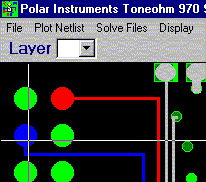Closest equivalent in production Toneohm
950
![]()
|
Toneohm 970 |
|
|
 Bare board repair The Toneohm 970 is designed specially
for the PCB industry, combining the latest short circuit
location techniques effective even on maximum copper
layers and backed by powerful CAD software which allows
you to simply and effectively highlight faulty nets.
|
Designed specially for bare board repair
When your BBT system identifies a short, you know which nets are shorted, but not the physical short circuit location. Using the Toneohm 970
you can locate and repair most shorts on all
To find shorts with the Toneohm 970 you use a combination of CAD information processed from IPC and NTD files. The 970 software enhances the ability of the 970 bare board shorts locator to home in and physically find the short circuit. The Toneohm 970 provides several methods for finding most common shorts, - a tone guided track resistance meter for simple track to track shorts - a current trace probe for locating higher resistance shorts, and finally plane shorts which allows you to find power to ground plane shorts or shorts between maximum copper layers. This technique first employed on the Toneohm 950 primarily for loaded boards has now been optimised for bare board applications - special clips are included to make connection to bare boards more straightforward. Polar calls this technique Vector Plane Stimulus or VPS... Why do you need the Toneohm 970? PCBs are becoming more complex and valuable in terms of both cost and the requirements for 100% yield in the production process. The rapid growth in multilayer fabrication techniques, surface-mount technology and fine line geometries means you simply cannot afford to spend excessive time locating faults such as short-circuits, since this adds cost and reduces quality. Scrapping the board results in even higher costs and unacceptable shortfalls in production yield. Since a significant percentage of shorts occur on outer layers they are relatively easy to rework once located. The Toneohm 970 helps you locate hairline shorts to maximum copper outers which are hard to locate with AOI alone.. If the board has an inner layer short isn't it impractical to repair? Feedback from our colleagues in the PCB industry tells us that most shorts occur on outer layers especially maximum copper outers which are hard to scan with AOI, as many as 90% of shorts can be traced to faults on the outers so its perfectly economical to repair and has no effect on the quality of the finished board. How does Vectored Plane Stimulus work? The ground and power planes of multilayer PCBs make it impossible for conventional test tools to accurately locate the origin of short-circuits. Polar's Vectored Plane Stimulus uses a combination of current injection and field sensing techniques to overcome these problems, enabling you to rapidly home-in on the precise fault area of a board. Locating shorts in multilayer PCBs could not be easier - you simply follow the arrows! After attaching specially designed stimulus leads to the shorted plane at or near the corners of the PCB, and a reference probe to the shorted network, you merely touch the tracing probe on any node of the failing network. The four-quadrant LED display on the Toneohm 970 indicates the direction in which you should probe to find the fault. Probing a few points brings you close to the short, at which point all four LEDs illuminate and you can use the CAD display to verify the most likely fault area. The fault-tracing process is accompanied by an audio tone which rises in frequency as the short is approached, together with a digital display of relative distance which enables extremely shorts location usually to within a few cm of the short. Visual inspection is then used to check the surrounding area. How does the 970 compare with other repair stations? Unlike most other bare board repair stations which are primarily software tools the Toneohm 970 is a package of both hardware and software designed to work together so providing an integrated solution to PCB short circuit location. You can download a free evaluation copy of the software from here to evaluate. If you already use a Toneohm 950 and would like to use the 970 software to complement it then drop us an email and we will give you the all information you need. The demo software includes and IPC + NTD file which you can use to familiarise yourself. You can also load one of your own files and use the software free for a limited number of Free operations. The Toneohm 970 is unique in offering Vector Plane Stimulus to physically locate plane to plane shorts. For more information please contact: USA / Canada Asia / Pacific Europe / ROW |
|